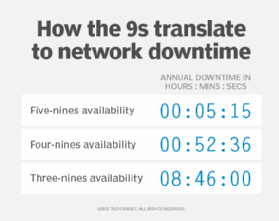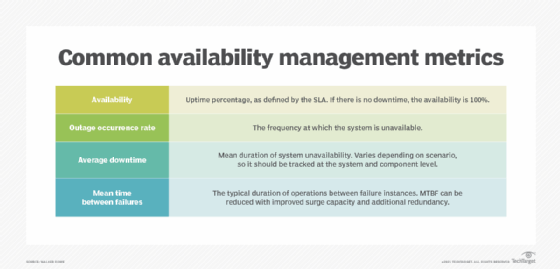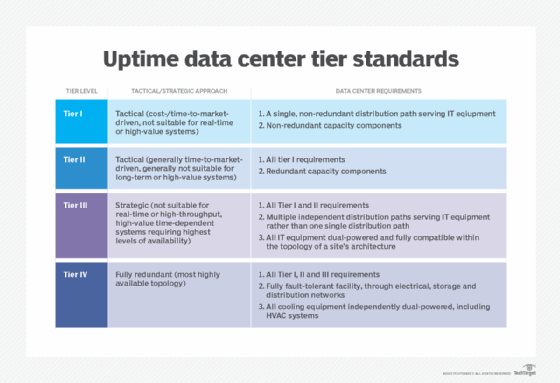Reliability, availability and serviceability (RAS) are associated operational actions that should be thought of when designing, manufacturing, buying and utilizing a pc product or part. The time period was first utilized by IBM to outline specs for its mainframes and initially utilized solely to {hardware}. At this time, RAS is related to software program as effectively and will be utilized to networks, functions, working programs (OSes), private computer systems, servers and even supercomputers.
The three elements of the time period imply various things. Collectively they describe the extent at which a consumer can count on a pc part or software program to carry out. RAS applies to a broad vary of know-how parts, together with {hardware} elements, central processing items (CPUs) and OSes, system firmware and specialised high-availability pc programs. From an administrative perspective, RAS addresses points akin to maximizing system uptime, minimizing system downtime, figuring out factors of failure and making certain information integrity.
How does RAS work?
Every a part of the time period reliability, availability and serviceability describes a selected sort of efficiency for pc elements and software program.
Reliability
The time period reliability refers back to the potential of pc {hardware} and software program to constantly carry out in accordance with sure specs. Extra particularly, it measures the chance {that a} particular system or software will meet its anticipated efficiency ranges inside a given time interval.
In concept, a dependable product is freed from technical errors. In follow, distributors generally specific product reliability as a share. The Institute of Electrical and Electronics Engineers (IEEE) sponsors the IEEE Reliability Society (IEEE RS), a corporation dedicated to reliability in engineering.

The nines are used to calculate the proportion of community availability assured in a service-level settlement (SLA) or different contract. They are often translated into quantifiable hours, minutes and seconds of allowable community providers downtime.
Imply time between failures (MTBF) is one metric used to measure reliability. For many pc elements, the MTBF is 1000’s or tens of 1000’s of hours between failures. The longer the uptime is between system outages, the extra dependable the system is. MTBF is dividing the overall uptime hours by the variety of outages throughout the commentary interval.
Service-level agreements and different contracts typically use the nines to explain assured ranges of reliability and availability. As an example, 5 9s means a reliability stage of 99.999% is being promised. The system or part in query might be accessible 99.999% of the time. Such programs may solely be down 5 minutes a 12 months, so 5 nines is a excessive stage of reliability. Organizations counting on high-availability programs typically require a minimal of 4 nines or lower than an hour of downtime per 12 months.
Availability
Availability is the ratio of time a system or part is practical in comparison with the overall time it’s required or anticipated to perform. This may be expressed as a proportion, akin to 9/10 or 0.9 or as a share, which on this case can be 90%. Full availability or 100% is the specified purpose.
To calculate availability of a part or software program program, divide the precise working time by the period of time it was anticipated to function. For instance, if a tool is working for 50 minutes out of an hour, it has 83.3% availability. MTBF can be utilized to explain availability in addition to reliability. The next MTBF would imply greater availability.
Typically availability is expressed in qualitative phrases. As an example, it’d measure the extent to which a system can proceed to work when a major factor or set of elements is unavailable or not working.

System and software program availability are measured by a number of totally different metrics. See 4 vital ones right here.
Serviceability
Serviceability is the convenience with which a part, machine or system will be maintained and repaired. Early detection of potential issues is a essential issue of serviceability. In figuring out serviceability, it is vital to think about how simple it’s to do the next:
- Diagnose points.
- Restore issues.
- Get hold of components.
- Take a system all the way down to impact repairs.
- Check the repaired system.
- Doc what was carried out
- Return it to operation.
Imply time to restore (MTTR) is a metric used to measure serviceability. It is calculated by taking the overall period of time spent on repairs in a given time interval and dividing it by the variety of repairs. For instance, if 20 minutes of time is spent on repairs ensuing from two outages, the MTTR is 10 minutes.
Some programs are self-monitoring and use diagnostics to mechanically determine and proper software program and {hardware} faults earlier than extra severe bother happens. For instance, OSes akin to Microsoft 365 embody built-in options that mechanically detect and repair pc points, and antivirus software program and adware autoprotect options embody detection and removing applications.
Ideally, upkeep and restore operations trigger as little downtime or disruption as attainable. The usage of AI for serviceability is a crucial enhancement. Along with supporting diagnostics and repairs, it might additionally analyze prior efficiency and supply insights on the chance of the merchandise failing sooner or later.

Knowledge facilities use uptime tiers, as specified by the Uptime Institute, to make sure the fitting ranges of availability are tied to particular elements, programs and software program.
Why is RAS vital?
Two key objectives of just about any info system are: for the system to remain operational so long as attainable and to be simply repaired and returned to service if a failure happens. Extra the reason why reliability, availability and serviceability are vital embody the next:
- Reliability. A very dependable system is reliable, reveals constant efficiency and has minimal to no outages. Reaching these attributes helps set up confidence and belief within the system.
- Availability. When a system fails, the group can expertise productiveness, buyer and income losses, in addition to reputational injury. Since availability is intently tied to reliability, system directors should use all of the instruments accessible to maintain the system performing as required.
- Serviceability. The power to rapidly and effectively repair a system that has been disrupted is essential to sustaining its efficiency. Ease of serviceability helps be sure that the MTTR is as little as attainable. Ease of troubleshooting is one other vital part of service administration, and plenty of instruments can be found to facilitate this important exercise.
With out an efficient suite of RAS procedures and instruments, system efficiency — and the corporate’s success — will be in jeopardy. AI is anticipated to be an vital part of RAS actions.
Execs and cons of RAS
Whereas some great benefits of reliability, availability and serviceability can far outweigh the negatives, each should be thought of when initiating or updating RAS initiatives.
- Reliability. Holding programs dependable means they carry out constantly with out interruption, leading to minimal downtime and decreased upkeep prices.
- Availability. Holding essential programs accessible to clients helps guarantee their satisfaction and continued use, making certain income safety for the corporate. Managing availability implies that extra know-how, e.g., redundant elements and information backups, is likely to be wanted, doubtlessly including prices.
- Serviceability. If essential programs will be simply fastened, their availability and reliability are improved. This helps decrease downtime, enhance efficiency and scale back general upkeep prices over time. Funding in the fitting restore instruments and applied sciences is likely to be wanted in addition to skilled restore personnel and coaching for restore techs — all of which might add to working overhead.
Vital RAS options and design parts
There are lots of methods to enhance availability and reliability, particularly. These embody deploying pc programs and subsystems with extra highly effective CPUs, and a number of processors and reminiscence modules, and utilizing part redundancy, error detection firmware and error correcting code. AI might be an vital issue within the enhancement of system reliability.
Among the key ways in which RAS is designed into {hardware} and software program are the next:
- Overengineering. Methods are designed past the minimal specs.
- Duplication. In depth use of redundant programs and elements eliminates single factors of failure and improves RAS.
- Recoverability. Fault-tolerant engineering strategies assist guarantee RAS.
- Computerized updating. These programs hold OSes and important functions present with out consumer intervention.
- Knowledge backup. Efficient information backup prevents catastrophic lack of essential info and maintains information integrity.
- Knowledge archiving. Archiving programs guarantee older information is obtainable when wanted for audits and restoration wants.
- Energy-on alternative. That is the flexibility to scorching swap elements or peripherals, making upgrades and repairs simpler.
- Digital machines. The usage of VMs minimizes the affect of OS and software program points.
- Surge suppressors. These decrease the chance of part injury ensuing from energy anomalies.
- Steady energy. Uninterruptible energy provide lets programs stay operational when there’s an interruption within the common energy provide.
- Backup energy sources. Batteries and turbines hold programs operational throughout prolonged energy interruptions.
Be taught the necessities of designing an information heart effectively. Try key elements, infrastructure and trade requirements earlier than embarking on the mission. Discover the what components to think about to run a sustainable information heart.
…………………………………………
Sourcing from TechTarget.com & computerweekly.com
DYNAMIC ONLINE STORE
Subscribe Now
Leave a Reply